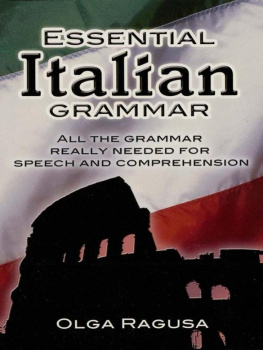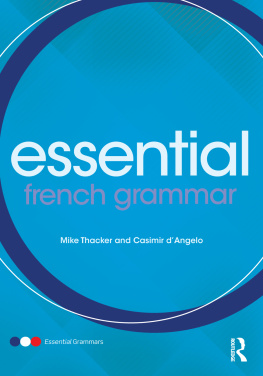Modern
ITALIAN
Grammar
Modern Italian Grammar is an innovative reference guide to Italian, combining traditional and function-based grammar in a single volume.
The Grammar is divided into two parts. is carefully organised around language functions and contexts such as:
giving personal information
social interactions
register and style
oral communication and telephone skills
formal and informal written communication, including SMS and email.
With a strong emphasis on contemporary usage, all grammar points and functions are richly illustrated with examples. Implementing feedback from users of the second edition, this text includes clearer explanations, as well as a greater emphasis on areas of particular difficulty for learners of Italian.
This is the ideal reference grammar for learners of Italian at all levels, from beginner to advanced. No prior knowledge of grammatical terminology is needed and a glossary of grammatical terms is provided.
This third edition of the Grammar continues to be complemented by the Modern Italian Grammar Workbook, Second Edition, which features related exercises and activities.
Anna Proudfoot is Head of Italian at the Open University, UK. Francesco Cardo taught at the Liceo Scientifico E. Majorana in Pozzuoli, Naples.
Routledge Modern Grammars
Series concept and developmentSarah Butler
Other books in the series:
Modern Mandarin Chinese Grammar
Modern Mandarin Chinese Grammar Workbook
Modern French Grammar, Second Edition
Modern French Grammar Workbook, Second Edition
Modern German Grammar, Second Edition
Modern German Grammar Workbook, Second Edition
Modern Italian Grammar Workbook, Second Edition
Modern Russian Grammar
Modern Russian Grammar Workbook
Modern Spanish Grammar, Third Edition
Modern Spanish Grammar Workbook, Third Edition
Modern
ITALIAN
Grammar
A practical guide
Third Edition
Anna Proudfoot and Francesco Cardo

Third edition published 2013
by Routledge
2 Park Square, Milton Park, Abingdon, Oxon OX144RN
Simultaneously published in the USA and Canada
by Routledge
711 Third Avenue, New York, NY 10017
Routledge is an imprint of the Taylor & Francis Group, an informa business
2013 Anna Proudfoot and Francesco Cardo
The right of Anna Proudfoot and Francesco Cardo to be identified as authors of this work has been asserted by them in accordance with sections 77 and 78 of the Copyright, Designs and Patents Act 1988.
All rights reserved. No part of this book may be reprinted or reproduced or utilised in any form or by any electronic, mechanical, or other means, now known or hereafter invented, including photocopying and recording, or in any information storage or retrieval system, without permission in writing from the publishers.
Trademark notice: Product or corporate names may be trademarks or registered trademarks, and are used only for identification and explanation without intent to infringe.
First edition published by Routledge 1997
Second edition published by Routledge 2005
British Library Cataloguing in Publication Data
A catalogue record for this book is available from the British Library
Library of Congress Cataloging in Publication Data
Proudfoot, Anna.
Modern Italian grammar: a practical guide/Anna Proudfoot and Francesco Cardo.3rd ed.
p. cm.(Routledge modern grammars)
Text in English and Italian.
Includes bibliographical references and index.
1. Italian languageTextbooks for foreign speakersEnglish. 2. Italian languageGrammar.
I. Cardo, Francesco, 1951II.Title.
PC1129.E5P762012
458.2421dc23
2012015143
ISBN:978-0-415-67187-3(hbk)
ISBN: 978-0-415-67186-6(pbk)
ISBN:978-l-136-19546-4(ebk)
Typeset in Times New Roman and Berthold Akzidenz Grotesk
by Graphicraft Limited, Hong Kong
Disclaimer: Every effort has been made to trace and acknowledge ownership of copyright. The publishers will be glad to make suitable arrangements with any copyright holders whom it has not been possible to contact.
In memory of Franco Cardo,
19512006
Contents
Modern Italian Grammar follows an entirely new approach to learning Italian. It looks at grammar not as the ultimate goal, but as the tool with which to construct a dialogue or a piece of writing.
Modern Italian Grammar is specifically designed to be accessible to the English reader not brought up in the Italian tradition of grammar and language analysis. It is unique both in its combination of formal grammar reference section and guide to usage organised along functional lines, and the fact that it was compiled by an English mother-tongue teacher of Italian and an Italian native speaker, working closely together.
It is the ideal reference text to use with newer language courses, for both beginners and advanced learners.
The course books and textbooks published over the last two decades are based on the principles of the communicative approach to language learning, which recognises that the objective of any language learner is to communicate, to get one's message across, and that there can be many different ways of doing this, rather than a right way and a wrong way.
The communicative approach emphasises language functions rather than structures. Traditional reference grammars present language by structure, making them inaccessible to learners who have no knowledge of grammatical terminology. Modern Italian Grammar presents language by function, with examples of usage and full explanations of how to express specific functions in , which illustrates language forms and grammatical systems in a schematic way: word formation and morphology, verb conjugations, tenses, use of conjunctions and verb constructions.
The language functions included have been based on the communicative functions listed in Nora Galli de Paratesi's Livello Soglia (1981), itself based on J.A. van Ek's The Threshold Level (1975), the statement of key language functions supported by the Council of Europe. We have expanded them to provide a richer variety of examples more suited to our target readership. The division into functional areas also takes account of general linguistic notions, which can occur in more than one function; these include notions such as presence or absence, time and space, cause and effect. Notions and functions are integrated throughout are accessed through extensive cross-referencing.
In our choice of examples, we have included as many different contexts as possible. Some examples are typical of everyday dialogue or writing; some have been taken from the press or television, others from contemporary texts.
Our guides and inspiration in putting together this grammar have been some of the recognised authorities in the area of Italian grammar in the last few decades: to them go our thanks and our recognition of the great debt we owe them: Anna-Laura and Giulio Lepschy (The Italian Language Today, Routledge, 1991); Marcello Sensini (Grammatica della lingua Italiana, Mondadori, 1990): Maurizio Dardano and Pietro Trifone (Grammatica Italiana, 3rd edition, Zanichelli, 1995); Luca Serianni (Grammatica italiana. Italiano comune e lingua letteraria, 2nd edition, UTET, 1991); Giampaolo Salvi and Laura Vanelli (













